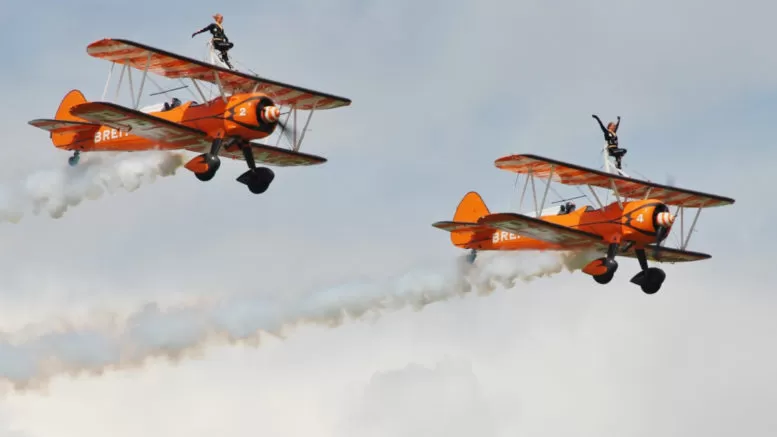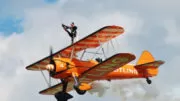A stunt airplane is structurally and functionally designed for complicated aerial moves and maneuvers. Due to the complexity of their use, their systems are intentionally engineered to defy gravity and scale successfully during steep stunts.
Technology advancement has aided the aeronautic and aviation industry in producing innovative, high-performing aircraft with new-age features.
Top Stunt Airplane Models
Before we dive deep into the list of the best aircraft for air show stunt flying, It’s necessary to note that aerobatic aircraft are subdivided into two distinct categories; Training and Aerobatics aircraft. The former is used primarily for training (especially by the military) and flight demos. On the contrary, the latter is explicitly designed for aerobatic applications and stunts.
Bearing that in mind, here are some of the most impressive aircraft history has ever recorded:
1. Extra 330SC
This aircraft, by research, is the world’s leading aerobatic plane, as pronounced by experienced acrobatic pilots. It was designed in Germany in 1987 by Walter Extra in a company called Extra Aircraft, using steel frames and carbon fiber as the primary raw materials for its production. Conceivably, the Extra 330SC was fabricated for excellent aerobatic performance and Impressive stunts.
The Extra 330SC is a propeller-controlled single-seat vehicle with fuselage fuel tanks on its wings at opposite sides of the plane. When empty, it weighs 1291 pounds, bearing the total weight of its thick and symmetrical silhouette propeller. As an exhibition aircraft, it is certified by the European Union Safety Agency (EASA).
2. Edge 540
The Edge 540 is a single-engine aircraft known for its incredible speed and impressive climb rate of 3700+ feet above sea level per minute. It was developed in 1995 by Zivko Aircraft in Oklahoma, United States, launching into the market with two distinct yet similar variants.
The Edge 540T variant offers two seats over the Edge 540, with only one seat space. Asides from the seat spaces, both are renowned as stable racing aircraft with swift maneuverability.
The Edge 540 is the most used aircraft in the Red Bull Air Race World Series.
3. Pitts S-2C Series
Pitts S-2C is a specially handcrafted and very adaptable high-tech plane made with an aesthetically fabricated patented propeller. It is renowned for its sleek straight lines, proper balance, and long hang time. Its propeller is popularly referred to as “the claw,” offering a wing span of about 20 feet.
Compared to other aircraft, the Pitts S-2C is an easily controlled high-power plane sought after by pilots in training since it guarantees an excellent aerobatic experience.
When empty, it weighs 1,155 pounds and offers enough seating space for two passengers. Being 17+ feet long, It can steadily handle negative 5 Gs and positive 6 Gs.
4. Sukhoi Su-29
The Sukhoi Su-29 is a handmade Russian aircraft from the Russian military force. It was developed to aid training for war and has an ancient long record of a steep learning curve. Sukhoi Su-29 is a very affordable piston-driven airplane that provides two seating spaces.
Since it was made of composite materials, it performs excellently in high altitudes at extreme temperatures.
In 1992, Sukhoi Su-29 entered the United States for operations; however, it favors pilots with past aerobatic experiences, so it’s not the best alternative for new pilots. There are speculations that the Russians substituted Extra 330Sc for Sukhoi Su-29 for their primary operations because it offers better qualities than the latter.
Another feature of the Sukhoi Su-29 is that it requires physical strength since its rudder pedals are less sensitive, giving it light control. It also has excellent visibility and makes terrific loops. Its cockpits are spacious and roomy, allowing the seats to appear semi-reclined in the cockpits. It also has a five-point harness, similar to car racers. Its gas tanks are situated in the fuselage on each wing on opposite sides of the plane.
What To Look for in a Stunt Airplane
It is generally accepted, and most experienced pilots will agree that having excellent skills and precision during maneuvers can be very thrilling. That is why some or all of these qualities are paramount when deciding which aircraft is best. However, when choosing the best aerobatic plane, there might be some differences in personal interests and opinions.
- Performance and Speed
- Aerodynamic features
- Weight and material construction
- Fuel tank placement and size
- Emotional and Visual appeal
- Safety
- Cross-country capability
- Cost of expenses and maintenance.
Pilots should consider all these elements when deciding which aircraft is best for stunt display and aerobatics. For those who perform for thrill-seeking audiences, it’s also necessary to consider what is most comfortable for the riders while giving them a premium aerobatic flight experience.
Learning to fly can be challenging for amateur pilots. With the right attitude to learning, a few basic skills, and a good amount of dedication, you should be ready to fly in no time! To be a pro, you must possess tenacity, great attention to detail, and develop your ability to multitask. The type and complexity of the plane being also flown considerably impact the difficulty level of any stunt.
Moreover, you can cut down unnecessary costs if your aircraft is adequately protected and maintained. Not checking all requisite qualities before a flight won’t guarantee the best experience. Great flight experience is sometimes influenced by the condition of the aircraft in motion. General safety measures should be made compulsory for every airshow attendee to ensure the safety of spectators, passengers, pilots, and even the aircraft.
Summary of Stunt Airplane Models
I suggest that the ideology of “personal best” aircraft is relative to the pilot flying and their experiences and expertise with different aircraft. When pilots are asked what they consider to be the essential qualities of an aircraft, most mention performance, speed, and aerodynamics as the core qualities. However, pilots are advised to consider all of the above qualities before choosing any aircraft for flight.
Ready to Soar with Us?


